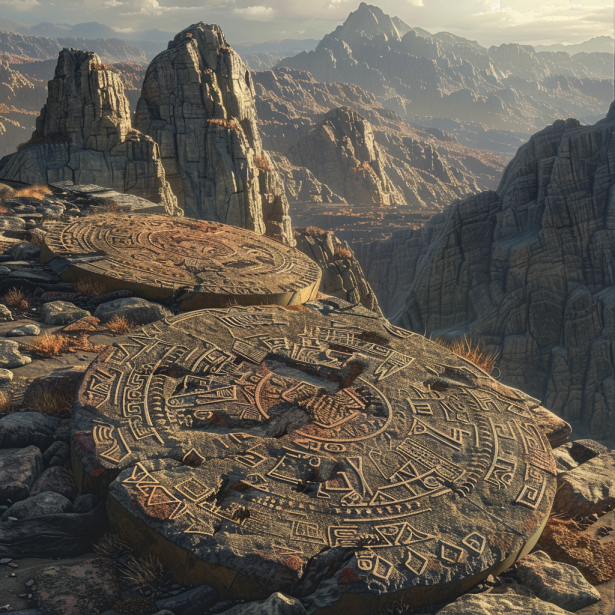Introduction
The Dropa Stones are one of the most intriguing and controversial artifacts in the study of ancient mysteries and alleged extraterrestrial contact. Discovered in the Baian-Kara-Ula mountains on the border between China and Tibet in 1938 by Chinese archaeologist Chi Pu Tei, these stone disks reportedly feature tiny hieroglyphic-like inscriptions. According to some claims, the inscriptions tell the story of a spacecraft that crash-landed in the region around 12,000 years ago, carrying beings known as the Dropa. These beings are said to have struggled to adapt to Earth’s environment and eventually perished.
Skeptics argue that the Dropa Stones are either a hoax or misinterpretation, pointing to a lack of credible evidence and peer-reviewed research. Despite these controversies, the legend of the Dropa Stones continues to captivate those interested in the possibility of ancient alien contact and the mysteries of human history.
Discovery of the Dropa Stones
Initial Excavation
The story of the Dropa Stones begins in 1938 when Chinese archaeologist Chi Pu Tei and his team reportedly discovered a series of stone disks in a cave in the Baian-Kara-Ula mountains. The disks were said to be about 9 inches in diameter, with a hole in the center and inscribed with tiny hieroglyphic-like markings spiraling out from the center.
Description of the Stones
Each stone disk, according to the legend, had a groove spiraling from the center to the rim, similar to an old phonograph record. The inscriptions, upon closer inspection, were believed to be microscopic characters telling an extraordinary story.
The Alleged Story of the Dropa
Translation of the Inscriptions
According to claims made by various authors and researchers, the inscriptions on the Dropa Stones were translated by Dr. Tsum Um Nui in the early 1960s. The translation allegedly revealed that the stones described a spacecraft that crash-landed in the region around 12,000 years ago. The occupants of the spacecraft, known as the Dropa, were unable to repair their ship and were stranded on Earth.
Struggles and Survival
The story goes on to say that the Dropa faced difficulties adapting to Earth’s environment and were initially feared and hunted by the local Ham tribe. Eventually, the Dropa and the Ham people came to coexist peacefully, but the Dropa could not survive in Earth’s conditions and ultimately perished.
Controversies and Skepticism
Lack of Physical Evidence
One of the main points of contention is the absence of verifiable physical evidence. The original stones have reportedly disappeared, and no credible documentation or peer-reviewed studies substantiate their existence or the alleged translations.
Academic and Scientific Criticism
Mainstream archaeologists and scientists argue that the Dropa Stones story lacks credibility. They point out inconsistencies in the accounts and the lack of verifiable data. Dr. Tsum Um Nui, for example, is not recognized in academic circles, and his translations are considered dubious.
Potential Hoax
Many skeptics believe that the Dropa Stones are a hoax or a misinterpretation of ancient artifacts. They suggest that the story may have been fabricated or exaggerated to attract attention and intrigue.
Ongoing Debate and Interest
Ancient Alien Theorists
Proponents of ancient alien theories continue to be fascinated by the Dropa Stones. They argue that the story fits into a broader narrative of ancient extraterrestrial contact and point to other mysterious artifacts and ancient texts as supporting evidence.
Cultural and Historical Impact
The legend of the Dropa Stones has had a lasting impact on popular culture and the study of ancient mysteries. It has inspired numerous books, documentaries, and discussions, contributing to the ongoing fascination with the possibility of ancient alien visitations.
Modern Research and Analysis
Technological Advances
Modern technology, such as advanced imaging techniques and material analysis, could potentially shed light on the authenticity of artifacts like the Dropa Stones. However, without access to the original stones, such investigations remain hypothetical.
Search for New Evidence
Researchers and enthusiasts continue to search for new evidence that might support or refute the story of the Dropa Stones. This includes exploring the Baian-Kara-Ula region for additional artifacts or signs of ancient habitation that could corroborate the tale.
Conclusion
The Dropa Stones remain one of the most controversial and captivating subjects in the study of ancient mysteries and alleged extraterrestrial contact. While skepticism about their authenticity is well-founded due to the lack of verifiable evidence and academic support, the legend persists in the realm of popular culture and alternative archaeology. As technology advances and new discoveries are made, perhaps more light will be shed on this enigmatic tale, revealing more about our ancient past and the mysteries that continue to intrigue us.
FAQs
What are the Dropa Stones?
The Dropa Stones are allegedly ancient stone disks discovered in China, said to bear inscriptions telling the story of extraterrestrial beings who crash-landed on Earth around 12,000 years ago.
Who discovered the Dropa Stones?
The stones were reportedly discovered by Chinese archaeologist Chi Pu Tei and his team in 1938 in the Baian-Kara-Ula mountains on the border between China and Tibet.
What do the inscriptions on the Dropa Stones allegedly say?
The inscriptions, according to some claims, tell the story of a spacecraft crash-landing and the subsequent struggles of its occupants, known as the Dropa, to survive on Earth.
Why is there skepticism about the Dropa Stones?
Skepticism arises from the lack of physical evidence, the absence of credible academic research, and the possibility that the stones are a hoax or misinterpretation of ancient artifacts.
What impact have the Dropa Stones had on popular culture?
The Dropa Stones have inspired numerous books, documentaries, and discussions, contributing to the ongoing fascination with ancient alien theories and the mysteries of human history.
What is the current status of research on the Dropa Stones?
Currently, there is no verifiable evidence or ongoing academic research supporting the authenticity of the Dropa Stones. Interest remains largely within the realm of alternative archaeology and popular culture.

